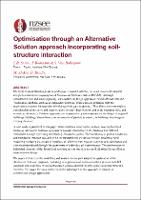| dc.description.abstract | The New Zealand Building Code is performance based. However, the most commonly adopted design methods utilise capacity-based Verification Methods such as B1/VM1. Although considerable time and cost is typically associated with a performance-based approach, it does present designers with the opportunity to assess the response of buildings with greater certainty. This allows for more explicit consideration of the stress and strain response in individual elements and in the founding soils, and as such a performance-based approach can be particularly advantageous for the design of atypical buildings, buildings where foundation response is of particular interest, or buildings that integrate existing elements.
A case study is presented in this paper where a performance-based nonlinear time history analysis was utilised to validate reinstatement of a building that suffered earthquake damage by reusing the existing foundation system. The uncertainty in ground conditions and foundation response was able to be incorporated into the design through detailed ground modelling including the effects of liquefaction, allowing nonlinear pile springs to be developed and conservatism reduced through the assessment of individual pile performance. The performance of individual elements of the lateral load resisting system was also assessed, allowing for an efficient superstructure design.
The paper will discuss the modelling and analysis techniques adopted in application of the performance-based approach, including amalgamation of international best practice with NZ standards and modelling of and performance criteria adopted for piles and critical superstructure elements. The paper will also comment on the advantages of this approach in relation to conventional design approaches. | |

